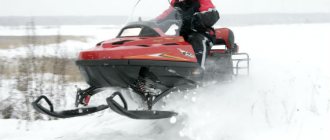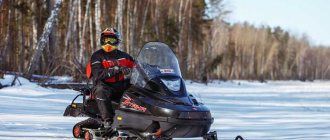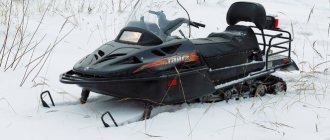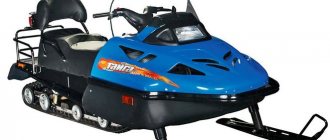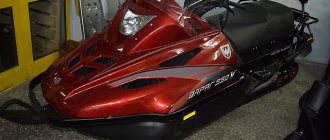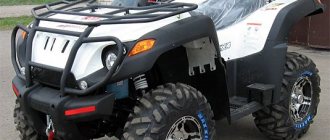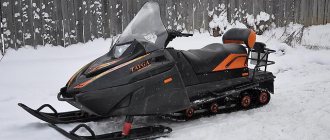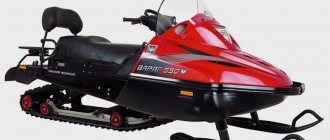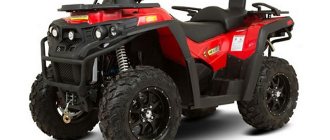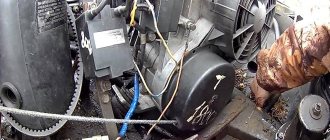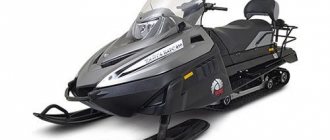All lovers of traveling through snowy fields are well aware of the fact that first you need to select high-quality equipment. Otherwise, you won’t be riding a snowmobile, but it will be riding you. One of the most interesting domestic brands is the Taiga snowmobile. In fact, this vehicle is a kind of high-quality SUV among similar cars (unlike the Buran brand).
History of appearance
Taiga snowmobiles have been produced since 1997. This version was developed for use in army units located in the north and by rapid reaction brigades. For many years (until 2015), snowmobiles were prohibited for retail or wholesale sale to private individuals.
And only in the last few years have civilians had the opportunity to fully appreciate all the capabilities of equipment with the Taiga 500 brand. Many immediately began to compare them with Buran snowmobiles, deciding which is better.
The model range of this brand includes several lines of double seats:
- Patrol;
- Leopard;
- Varangian;
- Leader;
- Satellite;
- Attack.
There are also lighter single-seat options:
- Rybinka;
- TIKSY 250.
How the Taiga snowmobile appeared
The history of the appearance of Soviet snowmobiles began in 1974. At that time, an aircraft manufacturing military plant was operating in the city of Rybinsk, which, by order of the ministry, was required to develop the production of goods for people in addition to what it did for the military industry. The choice of plant director Dergunov fell on snowmobiles.
Having received the order, the plant's design bureau began work. As a result, a new snowmobile was born. We all know it - this is the Buran snowmobile. It had a slightly unusual layout for those years - two driving tracks and one control ski. This technique has undergone numerous tests. Even those cars that were produced at the beginning still served until the very end of the USSR and after.
But the years passed, technology changed, the market changed. The new market economy brought us foreign snowmobiles, which, although they were not as reliable and repairable as the Buran, were distinguished by their high-speed qualities. Foreign cars had a little less maneuverability; they could not overcome loose snow with such confidence, walk calmly through forest thickets, snowdrifts, and overcome covered trees and stones.
Their only ski was well sprung, which gave good acceleration and riding comfort. So that it would be important for wealthy people, accustomed to the conveniences, whose trust everyone who produced goods in the 90s sought to win. So in 1997, 23 years after the start of snowmobile production, a new snowmobile, “Taiga,” was released at the Russian Mechanics enterprise in Rybinsk.
The Taiga differed from the previous model, which had gone through fire, water and copper pipes, with a well-sprung track, relative traction power and the ability to travel at high speeds. If previously a necessary accessory was a snowmobile sled, the Taiga was initially designed to overcome the snowy expanses without them.
Of course, on such a snowmobile you cannot bring firewood or the carcass of a killed elk from the forest, nor can you go pick up a barrel of diesel fuel for the village power plant. But what Russian doesn’t like to drive fast, as the classic said! It’s dangerous, but nothing compares to the splashes of snow scattering on the sides and quickly flying kilometers from the side. Even modern Burans began to be made according to this scheme.
Technical specifications
In total, in addition to the basic version of the Taiga 500 (not to be confused with the Buran brand), there are 9 more versions of these snowmobiles. They are assigned special markers (for example, snowmobile Taiga St500d). Let us consider in more detail the description of the basic parameters of technical characteristics:
- Case features. The frame is made of high-quality steel and is all-welded;
- Hood. Made from fiberglass. Elements such as a windshield (tuning is possible), a headlight and an instrument panel with a speedometer are mounted on it;
- Engine. The main ones are RMZ - 500 (power 38 hp and 1 carburetor) or the newest RMZ - 500 - 10 (power 50 hp, 2 carburetors). In addition, there are differences in lubrication. In the first option, the oil is mixed with gasoline, and in the second, the lubricant is separate. There are also versions with engines for different types of gasoline (76, 80 and 92). Fuel consumption depends on the version and the speed developed by the Taiga 500;
- Transmission (automatic V-belt variator);
- Disc brakes (controlled using a cable);
- The suspension (front) is equipped with a spring or hydropneumatic shock absorber. The rear (slime) is also shock-absorbed;
- The gearbox is a gear drive with manual gear shifting, of which there are 4 in the taiga (neutral, low, high and reverse).
Engine
The Taiga ST-500D snowmobile is equipped with a two-stroke power unit of the RMZ-500 brand, which runs on the AI-80 fuel mixture. This engine has two cylinders with a total displacement of 497 cubic milliliters and one carburetor. Air cooling system. The rated output power reaches 27.95 kilowatts, which translates to 38 horsepower.
additional characteristics
- Caterpillar. Its average width is about 500 mm. The cord is made of high-quality fabric, reinforced at the edges with fiberglass links in the form of rods;
- Also included in the chassis are ski runners made of high-quality steel. This allows you to better navigate areas with bare soil. To soften the ride, plastic ski linings are used. The main feature is that there are always 2 skis (the Buran snowmobile comes with one). In addition, this element provides the possibility of tuning (for example, installing extensions for skis on a Taiga snowmobile);
- Imported belts are installed (Dayco);
- The sock is secured with rivets and is made of molded polyethylene;
- With a total load capacity of 200 kg, it is possible to attach a trailer weighing up to 220 kg. And this despite the fact that the dimensions of the snowmobile are quite modest. If you don't need a trailer, then choose a model with its own trunk.
How much does it cost, where to buy new and used
The new Taiga Attack 2 costs 380,000-399,000 rubles. It is sold in any motorcycle showroom that is a dealer. Users greatly reduce the price for used snowmobiles, here are examples of offers from different countries and cities:
- Announcement from Kazakhstan: a 2011 snowmobile in excellent condition is being sold for 259,000 rubles.
- Offer from Yekaterinburg: a snowmobile from 2013, little used - sold for 280,000 rubles.
- A seller from Moscow is offering a snowmobile without an engine and a muffler with a damaged front suspension for 110,000 rubles.
- Announcement from Kemerovo: a snowmobile that requires replacement of the front glass and middle roller is being sold for 248,000 rubles.
- Offer from Noyabrsk: “Taigu Attack 2” with a mileage of 6,700 km, a damaged seat and scratches on the body is being sold for 179,000 rubles.
Advantages of a snowmobile
All models demonstrate the ability to reach speeds from 60 to 100 km/h even in heavy and deep snow. It also handles corners very well. In this regard, all models are much better than Buran snowmobiles. And this is primarily due to better stability.
Even when the size of the vehicle increases due to the trailer, the snowmobile demonstrates very good uphill climbs. In general, the Taiga behaves on the road like a full-fledged all-terrain vehicle, and can be a good alternative for fans of extreme off-roading. In addition, tuning fans note the good adaptability of modifications to modifications.
Overview of the device and equipment
Taiga Attack belongs to the touring class of snowmobiles, so it is strange to expect heavy-duty filling from it - it is just enough to carry out safe and smooth off-road riding for entertainment purposes. If you use it for extreme and sports driving (making high jumps, intentionally crashing into obstacles, trying to drive through water, etc.), then the equipment will quickly fail. For utilitarian purposes, a snowmobile is ideal.
Engine RMZ 551
The RMZ 551 motor, as supplied by the manufacturer, is only a two-stroke two-cylinder. A 4t engine can be available when purchasing a Taiga Ataka 551 II snowmobile after modification (for example, after installing a “non-native” power unit from Daewoo Matiz, Taiga Patrul or Lifan). Power unit power - 65 horsepower; volume – 553 cm³. The snowbike accelerates to 110 km/h. The engine is “hidden” under the hood (just lift the cover and you will have access to any component).
Japanese Mikuni carburetors are responsible for the reliability of the power system, and Ducati programmable CDI ignition is responsible for stable operation. The separate lubrication system of a two-stroke engine ensures timely application of material to all components of the snowmobile's power system. In addition, economical use of the product is ensured due to high dosing accuracy.
Fuel system
The capacity of the oil tank is 2.5 liters. The volume of the fuel compartment is 40 liters. Both tanks are placed in a bracket on the snowmobile frame. The neck is equipped with a lid with a liquid level indicator inside.
The car's fuel consumption is moderate. For 100 km when driving on trampled snow at a speed of about 30 km/h, Taiga Attack 2 will consume 24 liters. If you add a maximum load, the consumption will increase to 26 liters.
Why is there a receiver in Taiga Attack?
The snowmobile is equipped with a receiver K20500030. It was not installed on the 1st generation Taiga Attack; instead, the pipes were connected with a simple hose. The receiver is designed to stabilize pressure, smooth out air pulsation and increase the service life of parts.
Transmission
The Taiga Attack 2 has a V-belt variator and gearbox. The shift lever is on the left and has 4 positions: neutral, first gear, second gear and reverse. The variator is manufactured at . But the belt is an American Xtreme model with a Kevlar cord base. Size: 35x14x1118mm. The belt has high strength, wear resistance and allows for instant response when accelerating.
Suspension
The propulsion unit includes a gooseneck, a drive shaft with wheels and a sliding rail suspension. The rear suspension has 2 pneumatic-hydraulic shock absorbers, which smoothes out the ride over uneven surfaces. Its stroke is 370 mm. The suspension adjustment is ratchet.
The front suspension is lever type with a travel of 205 mm. Its advantage is easier control of the car during a forced snowmobile jump.
Snowmobile track Taiga Attack 2
Dimensions of the track from the snowmobile Taiga Attack 2 – 3937×500×22 mm. The number of steps is 62. The Composite Tract tape is characterized by reinforced load hooks (from heights of 22.5 mm). It is also distinguished by a wide track, which provides confident grip on the surface and good maneuverability of the snowmobile in deep snow.
If the tape is damaged and you cannot find the original part (Taiga 500 ICE) - no problem. For this snowmobile you can buy a COMPOSIT BEAVER WT track.
What are slicks suitable for?
The manufacturer uses a BLACK SLIDE made of lightweight plastic for the Taiga Attack. They are made in Canada (from Camoplast). They glide well, but, unfortunately, they often crack. If necessary, they can be replaced with any slip with number C40200503 (for example, from BRP Ski-Doo, Lynx snowmobiles).
Brake system
The Taiga Attack 2 has a hydraulic disc brake. It has such advantages as the absence of backlash. Thanks to hydraulics, the accuracy of braking force control and the immediate removal of the pads from the disc when the handle is released increases. The disadvantages include high cost (a fully assembled brake structure costs from 9,900 rubles) and a design unsuitable for repair in the field.
Steering
The snowmobile's handling is intuitive and responds well to the slightest turns. The motorcycle-type handlebar is rigidly connected to the steering shaft, which is increased by 80 mm (compared to previous Taiga models). The basic package includes a protective cover, heated grips and gas trigger.
Cooling system
The cooling system in Taiga Attack is liquid. Compared to its air counterpart, it allows you to increase power by 10% without excessive overheating. The only thing is that users make complaints about an increase in temperature when working at above-zero air temperatures on ice and crust without powder snow. In this case, many decide to bleed the cooling system - for example, to provide a snowmobile forcibly cooled by an air flow from an electric fan. For ease of control, it can be equipped with a separate toggle switch.
It is important to observe the filling volumes of the cooling system: the minimum level of antifreeze should be 1/3 of the tank, the maximum – 2/3 of the tank (check on a cold engine). The coolant in Taiga Ataka 2 is a mixture of Febi 02374 concentrate (60%) and distilled water or SWAG 99 90 2374 (40%).
Noticed shortcomings
According to owner reviews, there are not many disadvantages. Some people note that under increased loads the smell of fuel is felt. Also, a snowmobile is often recommended for those who are just starting to train in extreme driving. Still, the taiga cannot replace a full-fledged SUV.
But for training, all models will be good. Experienced drivers often lack power when driving through deep drifts. But overall the reviews are mixed. Some people claim that a snowstorm is better, others say the opposite.
Many note rather high prices. But it’s worth noting right away that this is due to the large number of imported parts in the assembly. Even those elements that are produced here are often made from new imported materials (which will be better).
Advantages and disadvantages
Examples of positive reviews for the Taiga Ataka 551 snowmobile:
- “Excellently passes through snowdrifts under 2 meters” (Vladimir, Altai Territory)
- “I’ve been using this snowmobile for hunting for 3 years now, not a single breakdown” (Evgeniy, Omsk)
- “This is my third snowmobile, but Taiga Ataka has the most comfortable fit and stability on loose snow” (Serega, Voronezh)
- “It starts in cold weather with half a turn. The steering qualities are excellent, no bumpiness when driving” (Ivan, Tyumen).
- “It maneuvers well in the forest, even in deep snow” (Leonid, Rybinsk).
- “Compared to the Yamaha that I had before, repairs are rarely needed and parts cost pennies; they are always easy to find on Drom and Avito” (Denis, Novosibirsk).
Examples of negative reviews from owners of the Taiga Ataka II 551 snowmobile:
- “For domestic equipment the price is a bit high, even a used one costs as much as a new Buran, which I like better” (Alexander, Krasnoyarsk Territory).
- “2.5 liters of oil per 100 km is a bit much. The Varyag 550 v has one tank for 120 km” (Dima, Moscow).
- “I don’t like the appearance and it gets very hot in heavy snow, so I had to tune the hood myself and improve the cooling” (Timur, Perm region).
- “The handles on the back seat are annoying - because of them you can’t lift the seat or put something oversized back” (Vladimir N., St. Petersburg).
- “The Attack snowmobile suits me, but snow constantly gets under the seats.”
- “It runs well at temperatures down to -30 degrees, if lower, it won’t start right away. And we actually have harsh winters. And changing the oil too often, of course, is very annoying” (Roman, Novosibirsk).
- “It doesn’t develop speeds above 7000. And after traveling 800 km, the starter broke and the glass cracked. I spent a long time looking for a repairman in my area, no one wanted to tinker with Taiga” (Semyon, Bashkortostan).
Criterias of choice
First of all, you should pay attention to snowmobile skis. They provide stability on snow and high maneuverability. On average, the normal track will range from 900 to 1000 mm. Please note that this parameter is calculated between the centers of the ski runners, and not from the edges.
If you are not afraid of independent tuning, then you can purchase a version with a more modest configuration. Otherwise, it is better to give preference to improved versions (even installing heated seats and windshield).
Naturally, a more powerful engine provides better cross-country ability. But which option to choose is up to you. You should focus on your needs.
Functionality
Before the Taiga Varyag 500 went on sale, it was tested for several years on the Kola Peninsula. The snow bike passed all tests perfectly, but this is a very difficult region. The technology showed itself well when driving to mountain peaks, easily overcoming deep snow masses, driving along frozen rivers, conquering wet slopes and muddy forest foothills.
The snowmobile really has high cross-country ability, reliability and convenience. At the same time, the Varyag 500 is the lightest snowmobile in the TAIGA family (dry weight 265 kg), which provides the vehicle with maneuverability.
Repair and service
Unless you are a specialist, it is better to entrust the repair of a Taiga snowmobile to a service center. Fortunately, the case provides fairly easy access to the structure. Although, breakdowns do not happen very often. This is due to the high quality of the spare parts used (most often imported) in the domestic assembly.
Previous post Suzuki Bandit 400 - technical characteristics of the motorcycle
Next entry Characteristics and advantages of the Buran snowmobile
Is it worth buying: comparison with competitors and conclusions
Overall, the snowmobile leaves a pleasant impression. It is worth buying for people who need to use a snow bike without too much extreme, in moderate frosts. For comparison, here are the main competitors of “Taiga Attack 2”:
- The Lynx snowmobile costs much less (RUB 102,000), but is slower and has less lifting capacity.
- Taiga Varyag 550 - has a wide track, a large fuel tank and a bright design. But this snowmobile was discontinued due to many defects (for example, the thermostat was poorly secured at the factory, which is why users had to reinstall it themselves).
- Buran A can be bought for 259,000 rubles, but under its hood there is only 34 horsepower, and it has a rather rough design, which is not to everyone’s taste.
- Taiga Patrol 800 - the track is even wider (600 mm), the fuel tank is larger, but there are 5 fewer horses than the Taiga Attack 2 and the price is slightly higher (about 419,000 rubles).
- Yamaha Viking is stronger than Taiga Attack 2, but the price is much higher (from 790,000 rubles).
- Polaris Voyager is a stylish snowmobile with elongated tracks, but the price is significantly higher than the Taiga Attack (918,000 rubles).
Thus, the Taiga Attack 2 snowmobile has decent technical parameters for its class. In terms of price, this all-terrain vehicle even beats its main competitors.
Weaknesses of the RMZ 550 engine
The pistons burn out. This problem is relevant for engine models produced before May 2013. The reason is a manufacturing defect: a deviation of the ignition timing by 3-5 degrees in the Ducati ignition system, which contributes to an increase in temperature during the exhaust stroke. This defect did not bypass the RMZ motors: 250; 551, which have the same ignition system. To prevent piston burnout and eliminate the defect, it is necessary to correctly adjust the ignition timing.
Ignition coil. If there are problems with the spark plugs, they often fail. A spare coil must be included in the transported spare parts.
Spark plug. If the spark plugs are faulty (carbon deposits, large gaps), backfires occur when the engine is running, and the internal combustion engine does not develop maximum power and maximum speed. To eliminate the defect, it is necessary to inspect the spark plugs for the presence of carbon deposits, remove carbon deposits if present, or replace the spark plugs. In addition, it is necessary to check the gap between the electrodes and bring it into compliance with 0.75 ± 0.05 mm.
Ignition. The ignition must be set very precisely. With early ignition, as with faulty spark plugs, backfire occurs during operation.
Leaking gaskets. Protrusions and oil leaks from under the oil pan gasket should not be ignored. If there are oily spots on the engine (under it), it is necessary to take measures to replace faulty parts. For uninterrupted operation, the engine must be periodically pressurized under a pressure of 0.35-040 kgf/cm² for 3 minutes, and the pressure should not drop for 3-5 minutes, since leaks in the internal combustion engine cannot always be determined by visible signs. If this is not done, then at one point the oil may leak out, and if there is no oil, the internal combustion engine will inevitably fail.
Carburetors. They require fine tuning for synchronous operation in all engine operating modes. Problems common to all carburetors: clogged jets, fuel leakage.
Fuel pump. If it fails, the operation of the internal combustion engine becomes impossible. To avoid problems during the trip, you should have a spare pump with you.
Variable speed drive. Requires periodic adjustment.
Belt variator. It is necessary to check the tension and condition of the belt daily. If the belt wears 3 mm in width, it needs to be replaced. Otherwise, the engine will not be able to develop maximum speed and power.
Fan belt. Failure to adjust the tension and wear of the belt leads to slippage and deterioration of the fan operation, and at the same time the engine overheats.
The rubber cushions (shock absorbers) under the engine are torn. The reason is poor quality tires.
